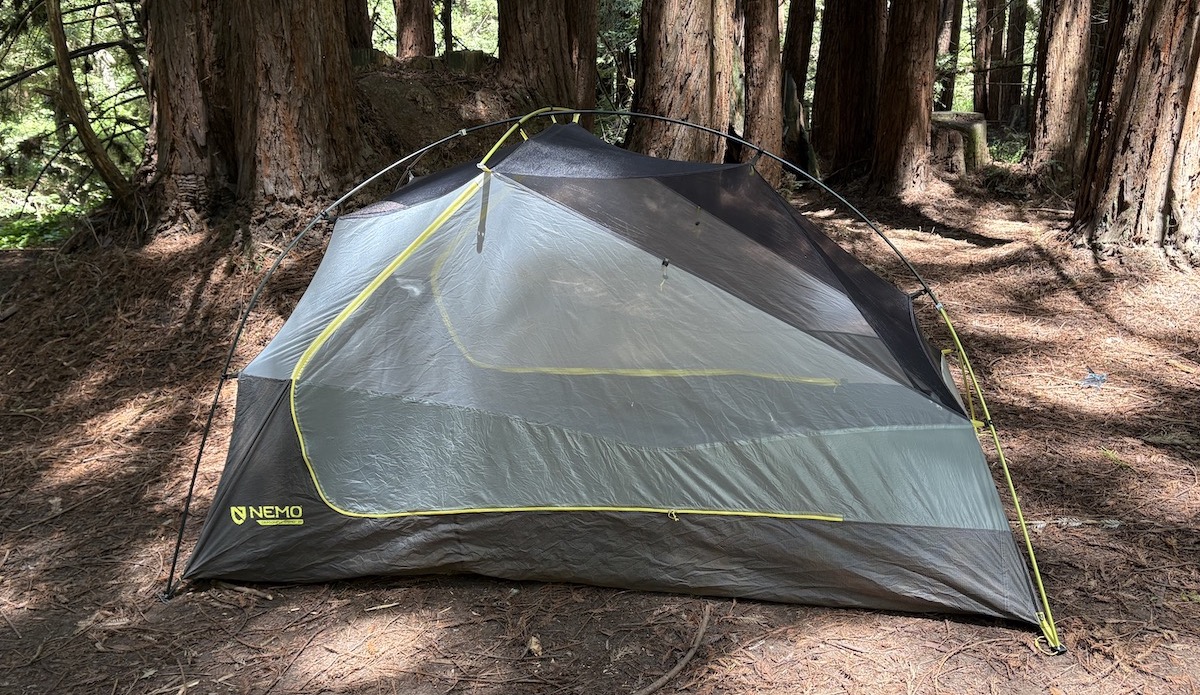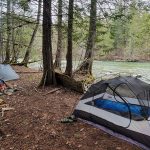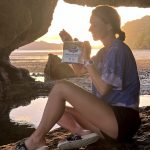Support our work! The Inertia may earn a small commission from affiliate links in this article. Learn more about our gear review policy here.

The Nemo Dragonfly OSMO Ultralight Backpacking Tent. Photo: Rebecca Parsons//The Inertia
![]()
My favorite part about backpacking is the splendor and quiet of hard-to-reach destinations. There’s nothing I love more than unplugging and heading out into the wilderness to reconnect with nature. Although I love the challenge of difficult treks and the reward of incredible views, I’ve never been a fan of toting around a heavy pack. Is anyone?
One of the most essential pieces of backpacking gear is your tent. A couple of years ago, I got my hands on the NEMO Dragonfly OSMO 2P Ultralight Backpacking Tent ($500). I split my time between Santa Cruz and Hawaii and have had the opportunity to test it out camping in warm and cold weather and on short trips and longer ones. It’s safe to say it’s an incredible tent.
In Short: Weighing just 3 pounds 2 ounces, the Nemo Dragonfly two-person backpacking tent is lightweight and compact without sacrificing performance. Made from durable and recycled materials, the Dragonfly is spacious, secure, and delivers a comfortable night’s sleep in a wide range of conditions.
Related: Best Backpacking Tents | Best Camping Tents | Other Backpacking Reviews
Pros
Cons
Sustainably made
Set up can be a tad tricky the first time
Two doors and two vestibules
Tight squeeze for two
Easy to pack down and packs into two separate packs so it’s easy to split the weight
Door tie-backs are confusing
Poles are color coordinated for easy set up
Testing the Nemo Dragonfly in Hawaii & California

Available Sizes: 1P, 2P, 3P
Tested Size: 2P
Minimum Weight: 2 lbs 10 oz
Packed Weight: 3 lbs 2 oz
Packed Size: 19.5 x 5.5 x 3.5 in
Floor Area: 29.0 sq ft
Peak Height: 41 in
Check Price on REI Check Price on Backcountry
As I mentioned above, I’ve owned the NEMO Dragonfly OSMO 2P for about two years and have had lots of opportunities to test it out. I split my time between Oahu and Santa Cruz and have brought the tent back and forth with me each time, shoutout to its compact size, and have used it on trips in both regions.
My first trip with the Dragonfly was on a four day backpacking trip to Volcanoes National Park on the Big Island of Hawaii with my husband. We’ve also taken it on a few single night trips near our home on Oahu. And most recently, I was able to test out the Dragonfly on a short backpacking trip under the redwoods near my other home in Santa Cruz. My husband and I have been loving the Dragonfly so much that we recently sold his old backpacking tent as we always find ourselves choosing the Dragonfly anyways.
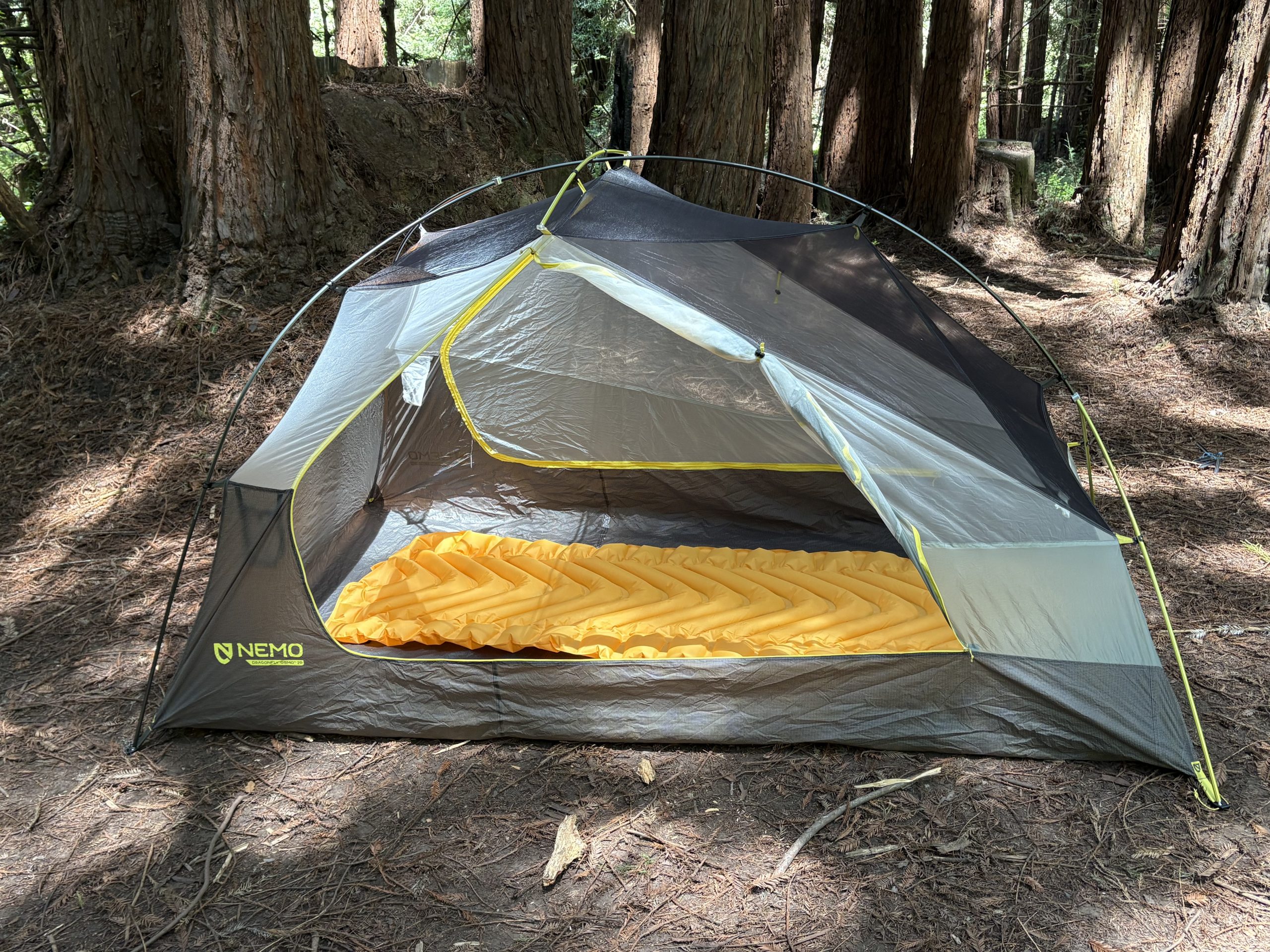
The Dragonfly is a high-quality, lightweight backpacking tent. Photo: Rebecca Parsons//The Inertia
What I Like (And Don’t Like) About the Dragonfly
The Set Up
Setting up the NEMO Dragonfly OSMO 2P is incredibly easy, once you get it figured out. The tent comes with both green and black poles, and the attachment points on the tent are color coordinated, which is something I had never seen before, but thought was pretty genius.

Make sure you put the green center pole over the black pole. Photo: Rebecca Parsons//The Inertia
My very first time setting up the Dragonfly I got all of the poles quickly and easily inserted and the tent erected. But for some reason, it just didn’t look right. On one end it was stretched taut but on the other, there was a little extra room. I messed around with the rainfly to see if it somehow got everything secured correctly once attached, but no dice. The tent was fully functional, it just didn’t look right.

The poles and rainfly are easy to attach. Photo: Rebecca Parsons//The Inertia
When I removed the rainfly the following morning I took another look at the poles and finally realized my problem. The green center pole was resting beneath the black poles. I removed it and replaced it, this time above the black poles and boom! The tent was perfect. This is something that in hindsight seemed incredibly obvious but if you are encountering a similar problem, this may be your solution as well.

Door tie-backs. Photo: Rebecca Parsons//The Inertia
I love that the poles snap on easily and clip into the corners. The rainfly is also easy to attach and get staked in to create ample protection as well as vestibules for a covered outer area for storing boots or anything that won’t fit in the tent. The tent includes door tie-backs but it’s embarrassing how long it took me to figure out how to get them working. Before setting out into the back country, do yourself a favor and practice setting everything up at home so you don’t find yourself in a frustrating situation.

The Dragonfly is durable and sustainably made. Photo: Rebecca Parsons//The Inertia
High Quality Materials
The Dragonfly features Nemo’s OSMO fabric that prioritizes both performance and sustainability. The 100% recycled composite fabric is PFAS-free, repels water 4x longer, and stretches 3x less when wet. The fly and floor materials were produced in an eco-friendly manner that adhere to strict ecological and chemical requirements. The silicone-impregnated fabrics use single-seam tub construction for increased longevity with minimal impact on the planet. Finally, the poles are lightweight and pre-bent to make set up as seamless as possible.
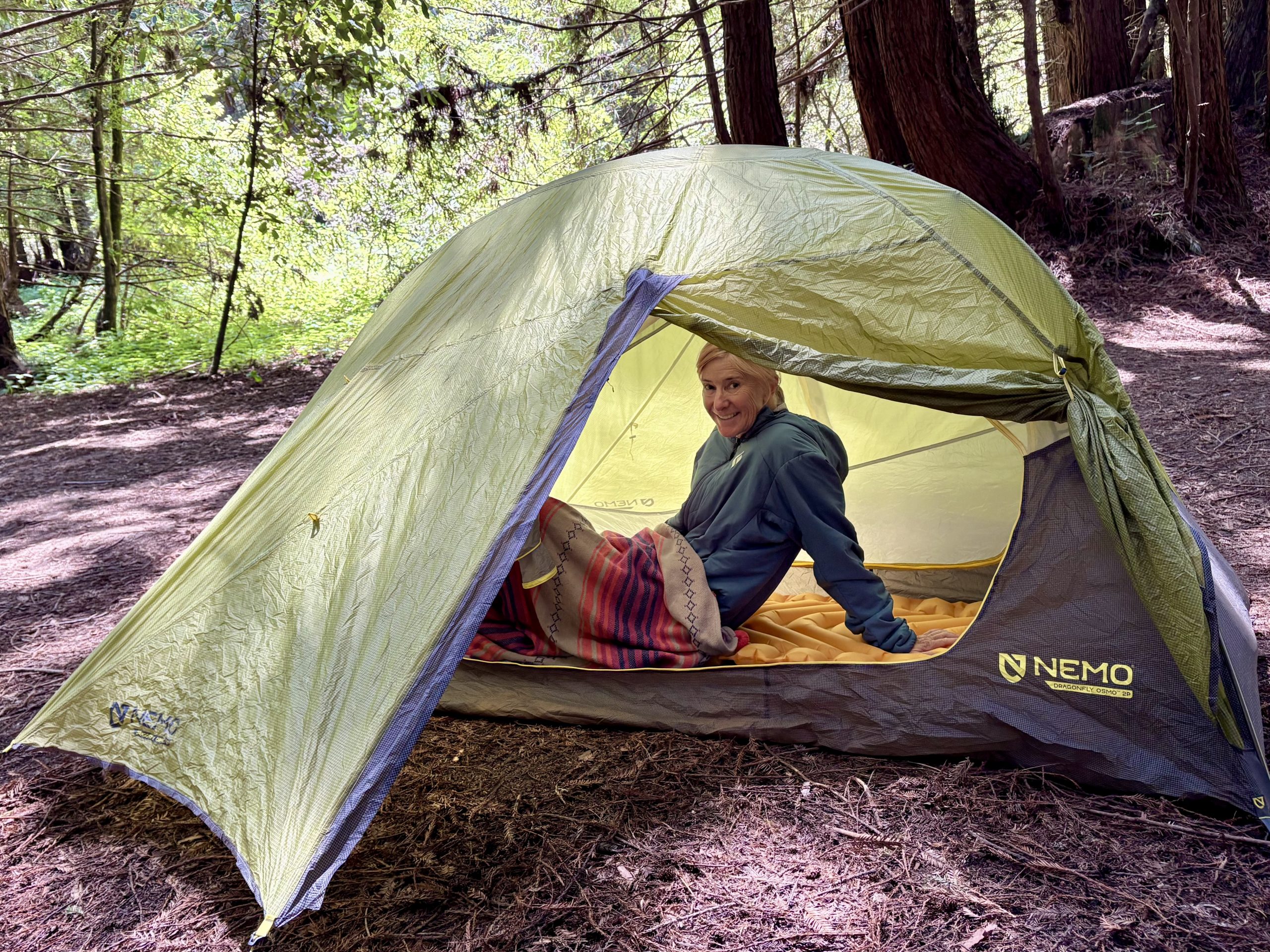
Space is tight in the Dragonfly but it works for two if you’re willing to squeeze. Photo: Rebecca Parsons//The Inertia
Living Space
Because the Dragonfly is designed to be as lightweight and compact as possible, it’s not the most spacious tent in the world. The two-person tent has a floor area of 29 square feet, and the floor dimensions are 88 x 50 inches at the head and 88 x 45 inches at the feet. The peak height is 41 inches, and the vestibule area is 10 square feet. It has just enough room for two sleeping pads and not much else, but it gets the job done. Plus, as a free-standing tent (meaning you don’t have to guy-line it out to set it up), there’s more space than most semi-freestanding options.

Pack, pad, pup, and a cozy overnight in the backcountry. Photo: Rebecca Parsons//The Inertia
I typically use my pack as a pillow, which helps maximize the amount of space. The vestibule is a good place to keep boots, or if you’re feeling really cramped, you can leave your pack in the vestibule area. Using the tent with my husband worked well, but if you really like to spread out, you may prefer the 3P version.

The vestibules are a good place to store your pack or shoes. Photo: Rebecca Parsons//The Inertia
Weight
The NEMO Dragonfly OSMO 2P is advertised as an ultralight free-standing backpacking tent. The packed weight of the tent is 3 lbs 2 oz, while the minimum weight is just 2 lbs 10 oz. If you’re anything like me, you might be wondering what the difference is between the two weights. The packed weight is the weight of everything that the tent comes with: tent body, rainfly, stakes, poles, stuff sack, footprint, and guylines. The minimum weight, on the other hand, is the weight of only the essential tent items like the tent body, rainfly, and poles.

Lightweight, pre-bent poles help cut down on weight. Photo: Rebecca Parsons//The Inertia
If you don’t spend a lot of time researching backpacking tents, then you may be curious if 3 lbs 2 oz is in fact an ultralight tent. Put in the context of our Best Backpacking Tents guide: of the 11 tents on the list, only five weigh less than the Dragonfly. For the most part, none of the tents that weigh less than the Dragonfly rated as well, so it’s safe to say that yes, the Dragonfly is an ultralight backpacking tent that doesn’t skimp on quality. Plus, if you are using the tent for two people as it was designed, then you can split the tent amongst the two of you for carrying, cutting that weight in half.
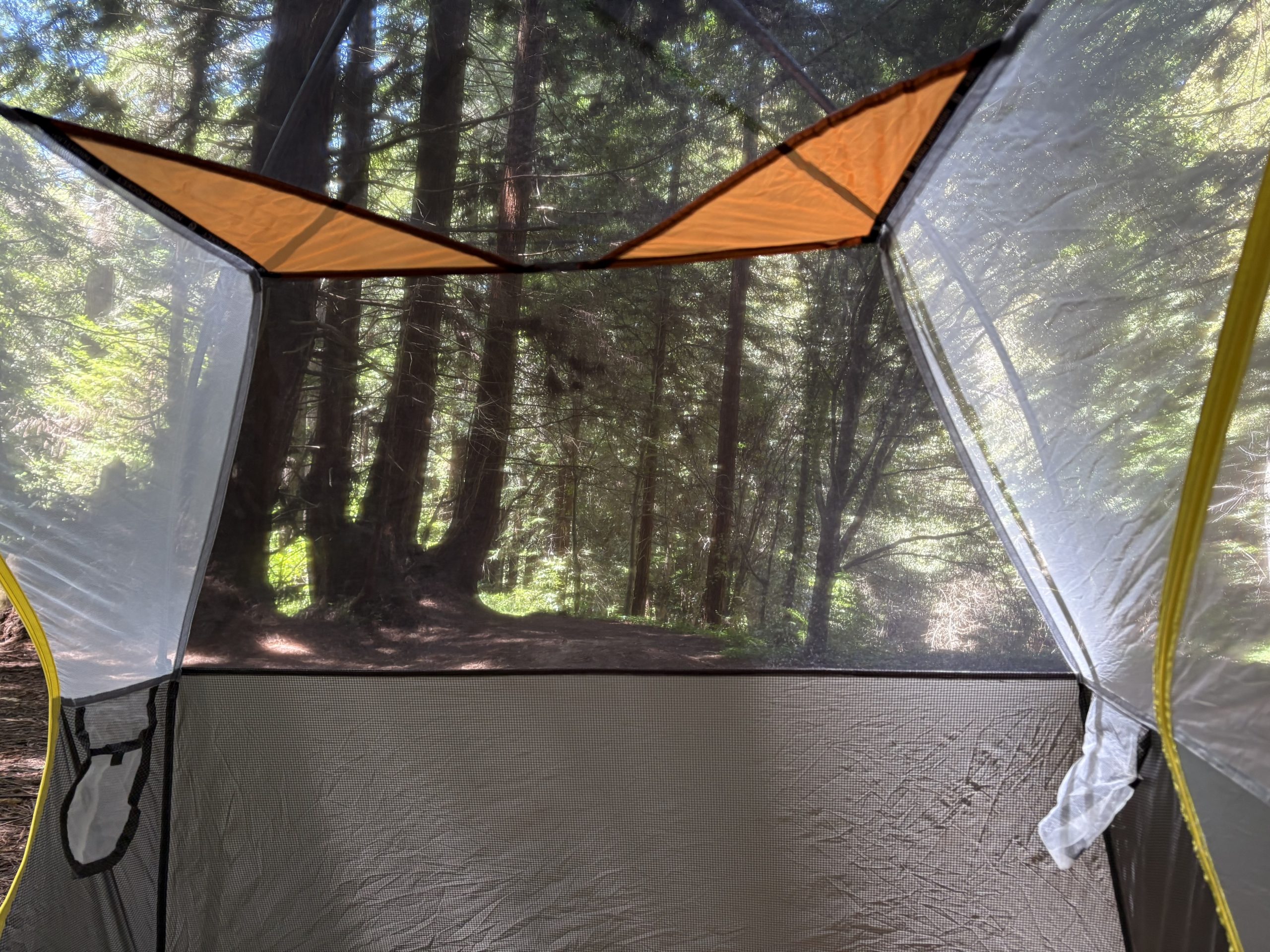
The fine mesh is perfect for enjoying the scenery without any pesky bugs. Photo: Rebecca Parsons//The Inertia
Extra Features
The NEMO Dragonfly OSMO 2P is complete with a few fun extra features to enhance your experience sleeping in the backcountry. If it’s a clear night, the tent has white no-see-um mesh panels for privacy paired with a black mesh top for stargazing and soaking up the scenery. I’m a fan of sleeping without the rainfly whenever possible, and I love how clear the mesh is on the Dragonfly.
The Dragonfly also has two doors, so you don’t have to climb over your tent mate for middle-of-the-night bathroom trips, and two cell phone pockets for essentials. Finally, the Dragonfly has an overhead nighlight pocket where you can transform your headlamp into a lantern in the evening.

The Dragonfly packs down into two separate sacks, so it’s easy to share the weight with your tent buddy. Photo: Rebecca Parsons//The Inertia
Tear Down
Remember back in the day when you had to perfectly fold up your tent to stand half a chance of getting it back into the bag? Luckily, those days are no more, at least with the Dragonfly. Removing the poles is quick and easy, and the stake includes a loop to help you pull them from the ground. If your stakes are in deep and secure, you can get a little rope burn pulling them out — to combat this, I wrapped my sweater around my hands and yanked.

The loops on the stakes make them easier to remove. Photo: Rebecca Parsons//The Inertia
The Dragonfly includes a rectangular stuff sack that’s super easy to stuff both the rainfly and tent back into. The poles pack away into a separate pack, so it’s easy to split the weight with your buddy or strategically situate the tent in your pack.

If you’re looking for a high-quality, lightweight backpacking tent, look no further than the Dragonfly. Photo: Rebecca Parsons//The Inertia
Final Thoughts
If you like to keep your pack as light as possible when hitting the trail, then an ultra-lightweight backpacking tent is essential. The NEMO Dragonfly OSMO 2P weighs just 3 lbs 2 oz and packs down into a 19.5 x 5.5 x 3.5-inch stuff sack. It’s extremely livable for the weight, and still represents one of the best true UL options on the market. To top it off, the Dragonfly is sustainably made and is backed by a lifetime warranty.
Check Price on REI Check Price on Backcountry
Related: Best Backpacking Tents | Best Camping Tents | Other Backpacking Reviews
The Best Backpacking Tents of 2025
We took some of the most popular backpacking tents into the field and tested them for livability, ease-of-setup, and overall performance. Here are our favs. Read more…
The Best Backpacking Meals of 2025
We taste-tested backpacking meals in the field to determine which filled us up, tasted best, and were easiest to pack. Hope you brought your appetite! Read more…

